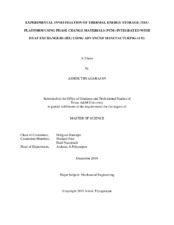| dc.description.abstract | The largest consumer of fresh water from natural resources in the US currently are the industrial cooling towers devoted to thermal power generation (for cooling of steam from turbine exhaust). As the energy demands are on the rise, the availability of water for the cooling purposes would be insufficient in the years to come. With increasing population eventually the fresh water resources will be stressed to capacity (both for meeting the increased human consumption as well as for addressing the increasing energy needs of the growing population). As a result, alternate technologies are needed to wean power plants from using fresh water resources. Dry cooling using air cooled heat exchangers is an alternative to wet cooling (i.e., by obviating cooling towers). However, this option results in reduced operational efficiency, higher costs (both for capital costs and operating costs) and reduced operational reliability. Air cooled heat exchangers installed in arid climates are inoperable on certain days during summer as the ambient air temperature can exceed the temperature of the steam at the turbine exhaust and may lead to power plant shutdown, in-turn, causing instability in the electric supply grid infrastructure (thus compromising reliability). In order to combat these shortcomings, supplemental cooling options may be needed. Thermal Energy Storage (TES) platforms can provide an attractive option for supplemental cooling. Phase Change Materials (PCM) are often used as viable options for Latent Heat Thermal Energy Storage Systems (LHTESS) as they have small footprint owing to the high latent heat values of PCM. The objective of this study is to analyze the performance of various LHTESS platforms by utilizing different configurations of the Heat Exchangers (HX) that are filled with PCM. The scope of this study is limited to using an organic Phase Change Material (PCM) and two different HX configurations are explored in this study: (a) two Shell and Tube Heat Exchangers that were fabricated using Advanced Manufacturing (AM) technique (i.e., “3D Printing”); and (b) a conventional Chevron Plate Heat Exchanger (PHX) that was procured commercially from a vendor. The thermal response and performance characteristics (e.g., power rating and HX effectiveness) of the two HX configurations are measured experimentally in order to ascertain their efficacy for melting and solidification of the PCM for different flow rates and inlet temperature values of the working fluid. The working fluid is called the Heat Transfer Fluid (HTF). The HTF used in this study is tap water. The PCM used in this study is PureTemp 29 (commercially procured from Pure Temp Inc., Minneapolis, MN). The propagation of the melt and the freeze fronts were monitored and tracked based on the nature of the transient temperature profiles recorded by an array of thermocouples. The array of thermocouples were strategically mounted at different locations within the HX containing the PCM. For the 3D-Printed HX (Shell and Tube HX), the thermocouples were located at different radial and axial locations within the shell containing the PCM. For the PHX, the thermocouples were located at different heights (for different plates containing the PCM). The transient values of the power and capacity ratings for the HX were estimated based on the time-history of the transient values of the temperature differential for the bulk temperature of the HTF flowing between inlet and outlet ports of the HX (and this was correlated with the transient profile and location as well as the propagation of the solid-liquid interface within the HX). The performance characteristics of both HX, analyzed from the experimental data, show that the average power rating for the melting-cycle is consistently higher than that of the solidification cycle due to the dominance of free convection during melting (resulting in higher values of the effective heat transfer coefficients for the same temperature differential values); while the
solidification process is dominated by transient conduction (resulting in lower values of the effective heat transfer coefficients for the same temperature differential values). | en |


